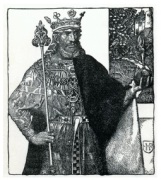 Advice wanted!! I am about to send out a book proposal for The Inklings and King Arthur to the major academic/university presses. I would like your advice on the length, content, wording, and organization of the following “overview.” This is the first section of the proposal (after the cover letter). Any ideas are welcome. If you know anyone in the publishing industry (especially academic publishing), please send it along to them for their suggestions. Cheers.
Advice wanted!! I am about to send out a book proposal for The Inklings and King Arthur to the major academic/university presses. I would like your advice on the length, content, wording, and organization of the following “overview.” This is the first section of the proposal (after the cover letter). Any ideas are welcome. If you know anyone in the publishing industry (especially academic publishing), please send it along to them for their suggestions. Cheers.
The Inklings and King Arthur: OVERVIEW

The 2013 publication of The Fall of Arthur, an unfinished poem by J. R. R. Tolkien, revealed a startling, previously-unknown aspect of Tolkien’s legendarium: Lancelot functions like Eärendel, sailing into the West to seek a lost paradise. This provides imaginative connections with The Silmarillion and with the Arthurian works of C. S. Lewis, Charles Williams, and Owen Barfield. The publication of this extraordinary poem thus invites an examination of the literary, historical, linguistic, and theological implications of the Arthurian writings by the major Inklings, their immediate predecessors, and their contemporaries.
 This collection of academic essays scintillates with insights into the powerful fantasies, histories, and poetry of the Oxford Christian writers. The authors in this collection, by design, range from well-established scholars in the fields of the Inklings and Arthuriana—such as Malcolm Guite, Robin Anne Reid, Holly Ordway, Kirstin Jeffrey Johnson, and Suzanne Bray—to younger and emergent scholars. The resulting variety of theoretical perspectives makes this a thorough, well-rounded volume. Issues of gender, sexuality, race, linguistics, geo-political imaginings, postcolonial concerns, historical appropriation, and intertextuality are addressed.
This collection of academic essays scintillates with insights into the powerful fantasies, histories, and poetry of the Oxford Christian writers. The authors in this collection, by design, range from well-established scholars in the fields of the Inklings and Arthuriana—such as Malcolm Guite, Robin Anne Reid, Holly Ordway, Kirstin Jeffrey Johnson, and Suzanne Bray—to younger and emergent scholars. The resulting variety of theoretical perspectives makes this a thorough, well-rounded volume. Issues of gender, sexuality, race, linguistics, geo-political imaginings, postcolonial concerns, historical appropriation, and intertextuality are addressed.
This volume first contextualizes the Inklings and King Arthur by rigorously examining their historical milieu and the condition of British Arthuriana. In all four writers’ worlds, evil is in the East; this is not surprising in an England increasingly threatened by continental aggressors. God’s country is in the opposite direction, across the sea, connected with ancient legends about Western Isles. The Quest for the Holy Grail is re-imagined during a resurgence of occult secret societies—a complex reaction to both war-weariness and scientific developments—and in conjunction with an increasingly mythological understanding of history and human consciousness. Predecessors are also considered: Arthur Machen, G. K. Chesterton, and George MacDonald.
Next, a significant section is dedicated to The Fall of Arthur by J. R. R. Tolkien, followed by new perspectives on C. S. Lewis’s Ransom cycle and other Arthuriana, along with connections to T. S. Eliot’s waste land. The longest section is devoted to Charles Williams, looking at his work from hermetic, Eucharistic, gender studies, and geopoloitcal perspectives. In the conclusion, Malcolm Guite raises the question of the ongoing and future relevance of these works.


As an emergent scholar about to embark on a PhD looking at the Inklings, King Arthur, and Myth, I am eagerly anticipating the publication of this book and the proposal sounds very exciting!
LikeLike
Great to hear from you, Ruth! Where are you studying? Let’s be in touch; perhaps you can review the book when it comes out.
LikeLike
In general I like this overview. I don’t know if words like “scintillates” will make it sound like we are tooting our own horn too much. If you have a sense of the particular interests of certain publishers, you may wish to tweak individual letters to emphasize overlap.
Let the bidding war for this manuscript begin!
LikeLike
Yeah; I already got rid of “scintillates.” 😉 Thanks for the comment!
LikeLike
The first three paragraphs are wonderful – full of energy and packed with tension. The last paragraph is dreadful – and should be scrapped and rewritten. It loses momentum, turns into a list (‘next’, ‘the longest section’, ‘conclusion’) none of which is (explicitly) related to the content set out in the first three paragraphs. As it stands, the overview veers between talking specifically about Tolkien’s Arthur and discussing the Inkling’s Arthur. The fourth paragraph needs to show how the essays in the book work to resolve the relationship between the two – and you need to state that relationship in the fourth paragraph.
LikeLike
Thanks, Simon. Are you in publishing? Do you review proposals?
LikeLike
I’m not in publishing. But I work as an editor. So I have a lot of experience in reading academic texts in this way. I’ll happily look over your whole proposal if you want (contact me via the Contact page on my website).
LikeLike
Pingback: The Geeks Shall Inherit the Earth… Or At Least Pass the Pepper | A Pilgrim in Narnia
Pingback: More Mythcon: Reblogged from A Pilgrim in Narnia | The Oddest Inkling
Pingback: Why is Merlin in That Hideous Strength? | A Pilgrim in Narnia
Pingback: Sørina’s 1st NaNo narrative | Ekphrasis: Allentown's Fellowship of Christians in the Arts
Pingback: Star Wars and the Sword in the Stone | A Pilgrim in Narnia